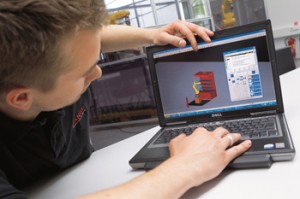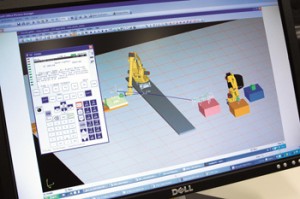Test and simulation software for robot installations
 The latest version of FANUC UK’s ROBOGUIDE software is a powerful simulation tool. It enables customers and integrators alike to precisely visualise and pre-programme a robotic installation in a safe and convenient virtual 3D world, before putting those plans into effect. As well as being able to predict and forestall potential new-build issues, ROBOGUIDE gives users a useful tool to scope out changing requirements and better plan for project upgrades. It can pre-empt – and help prevent – costly damage to the robot and potential injuries to co-workers.
The latest version of FANUC UK’s ROBOGUIDE software is a powerful simulation tool. It enables customers and integrators alike to precisely visualise and pre-programme a robotic installation in a safe and convenient virtual 3D world, before putting those plans into effect. As well as being able to predict and forestall potential new-build issues, ROBOGUIDE gives users a useful tool to scope out changing requirements and better plan for project upgrades. It can pre-empt – and help prevent – costly damage to the robot and potential injuries to co-workers.
ROBOGUIDE is available to end users as an option when incorporating FANUC robots into a line, as well as to system integrators. It provides a unique offline platform for accurate and time-efficient simulation of location and product-specific handling. “So, for example, you can plan around a post or pillar in the real world, as long as you model that in your simulation,” says FANUC UK project engineer Paul Coombes.
According to Paul, the software serves as a hugely valuable tool for any manufacturer of consumer goods constantly striving to keep its product range exciting and, as a result, continually assessing production line options, efficiencies and layout.
Testing the possibilities
“A food or pharmaceuticals manufacturer may ask: ‘Can I make this change on the line – and if so, how?’ With this software, they can answer that question,” Paul explains. “If they want to increase the speed of a line, they can run the simulation at the higher speed to see whether the robot would be able to cope.” All-important cycle times can be factored in to gauge the overall efficiency of the operation being modelled.
“Similarly, if the manufacturer wanted to add another pack size or a multipack to the line, or even integrate another robot, the simulation and proof-of-concept could be carried out in ROBOGUIDE,” says Paul.
As a strategic partner to FANUC, UK equipment supplier and integrator Pacepacker Services has used ROBOGUIDE for over five years. Technical director Richard Gladwin says: “It’s an extremely useful tool for demonstrating to customers that the concept they propose can be achieved. You can, for example, import 3D models of end-tooling and include conveyors, and so on.”
 Function-specific modules include PickPro for pick and place robots and PalletPro for palletising. In these and other modules, all variables can be experimented with and put through a virtual trial, from product or container shape/size in pick and place to palletising patterns in PalletPro.
Function-specific modules include PickPro for pick and place robots and PalletPro for palletising. In these and other modules, all variables can be experimented with and put through a virtual trial, from product or container shape/size in pick and place to palletising patterns in PalletPro.
Robot arms are powerful and – at the same time – represent a considerable investment. As a result they tend to be treated with a justifiable level of caution. ROBOGUIDE can deliver reassurance at the very earliest stage of concept development, highlights Paul. “As long as the immediate environment is modelled just as it is in the real world, any potential collision will be flagged up in red,” he says. “For immediate reassurance, the user can skip straight to the test point.”
All FANUC robots are equipped with Dual Check Safety (DCS) software, and the ROBOGUIDE add-on features of DCS Position and Speed Check allows engineers building concept prototypes to zone off an operator area (such as an inspection station) using lightguards. The software makes it easy to create and visualise a safe area of this sort.
Similarly, where robots are integrated with a vision capability, this can be added to the ROBOGUIDE simulation via a specific plug-in.
From delta-style pick-and-place stations to heavy-duty 6-axis workhorses, the simulation package incorporates the vast majority of FANUC robots – all bar some very specialist and older models. It is regularly updated as new robots are added to the range. According to Paul, compatibility with robot models and software extends beyond the last six years. Only FANUC robots are available on the system.
Shaping users’ understanding
While a concept may start by using generic boxes or shapes, these can be substituted by CAD models of the actual product or container at a later stage. This creates added realism and helps those visual/spatial thinkers who are said to account for over 30% of the general population, according to research by neuro-linguistic psychologists. Instead of mastering concepts by explanation, these people respond to the physical demonstration of an idea.
It’s an extremely useful tool for demonstrating to customers that the concept they propose can be achieved. You can, for example, import 3D models of end-tooling and include conveyors, and so on.
Once a basic concept has been agreed, ROBOGUIDE also plays an invaluable role in refining that concept and – importantly – preparing the programme for use in the actual installation. “Before the robot is even installed, we can programme its movements in ROBOGUIDE, and then transfer that programme directly to the robot itself, or vice versa,” says Richard at Pacepacker. This means that as well as retaining a backup programme, it can be altered or added to at a later stage via the teach pendant, which is a handheld control and programming device. The same menus and displays are shown on the virtual teach pendant incorporated into ROBOGUIDE.
Paul emphasises the versatility and time-efficiency of the system: “If you were to pick one particular robot, for instance, model the entire cell, and later decide to switch to a different robot, ROBOGUIDE will automatically transfer all the data you have accumulated, and you can pick up where you left off.”
According to Richard, the quality of the simulations on ROBOGUIDE has always been good. But the latest versions have added more options and capabilities. “On the technical level, this now means we can access certain elements, such as the PROFIBUS configuration, which were not accessible before. This means you can enter a configuration where you communicate with external devices without doing this manually via the robot itself.”
Additionally, the latest version of ROBOGUIDE allows it to interact directly with the human machine interface (HMI). “It can be used to programme the HMI (again, before installation) and also to prove and test it,” he says.
This is just one of many features which differentiate FANUC’s ROBOGUIDE from many other offline programming and simulation offerings by robotics companies. In addition, using the FANUC system means that an end user avoids the costs of adding the software for a specific robot to a third-party simulation system.
At all levels of planning and programming, ROBOGUIDE can save time and money. “It makes installations and any subsequent modifications much quicker to implement,” says Paul. It helps to avoid potentially costly errors and – importantly – gives all parties visible reassurance that the robot can safely perform in the real world the tasks set during simulation.
Visit the FANUC website for more information.
See all stories for FANUC















